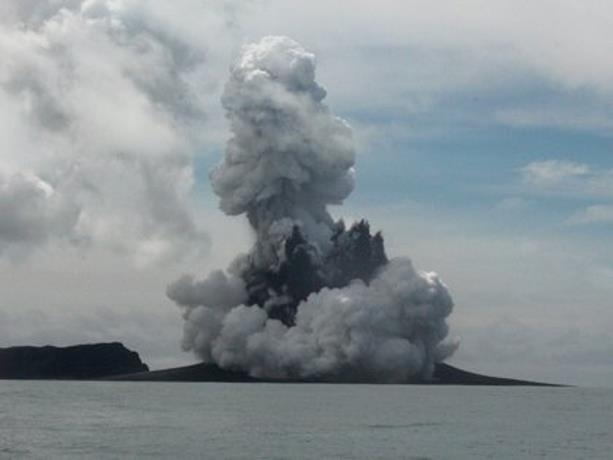World ‘sadly unprepared’ for a massive volcanic eruption and potential impacts on global supply chains, climate and food.
This is the conclusion of a study carried out by experts from the Center for Existential Risk Research (CSER) at the University of Cambridge and the University of Birmingham in England.
In their study published in the journal ‘Nature’, they confirmed “Widespread Misconception” The risks of large explosions are low, and ratio “irresponsible” Current lack of government investment in monitoring and responding to potential volcanic disasters.
However, researchers say it could be Take steps to protect yourself from volcanic destruction –from improving monitoring to increasing public education to dealing with magma–and the resources needed to do so are long overdue.
“Data collected from glaciers on the frequency of eruptions in deep time suggest that there is a one in six chance of seven eruptions in the next hundred years. It’s a roll of the dice – – explains the co-author of the article. Researcher at CSER, Dr. Laura Money, expert in global risk -. This kind of Massive eruptions c.Sudden climate changes and the collapse of civilizations in the distant past”.
Mani compares risk A 1 km wide asteroid hit the earth and a huge explosion. Such events can have similar climatic effects, but the probability of a volcanic catastrophe is hundreds of times greater than the combined chances of an asteroid or comet collision.
“Hundreds of millions of dollars are spent every year on planetary threats, but there is a serious lack of funding and global coordination to prepare volcanoes – remember the hour -. This needs to change urgently. We completely underestimate the risk that volcanoes pose to our communities.”
The explosion in Tonga in January was the largest ever instrumentally recorded. If it lasted longer, released more ash and gases, or if it occurred in an area rich in critical infrastructure, such as the Mediterranean, the researchers say.-, global shock waves could have been devastating.
“The Tonga eruption is the volcanic equivalent of an asteroid being lost to Earth, and T.should be considered a wake-up call” Mani says.
CSER experts cite recent research that has identified the regularity of large eruptions by analyzing trace sulfur spikes in ancient ice sheets. An eruption ten to a hundred times larger than Tonga occurs every 625 years, twice as often as previously thought.
“The last 7-magnitude eruption occurred in Indonesia in 1815 recalls Dr Mike Cassidy, a volcanologist and visiting researcher at CSER, now at the University of Birmingham and co-author of the study. An estimated 100,000 died locally. And global temperatures dropped by an average of one degree, leading to famines, violent riots and epidemics in a period known as the Year Without a Summer.
“We now live in a world with eight times the population and forty times the trade –Collaboration–. Our complex global networks will make us even more vulnerable to the impacts of a big explosion.”
Financial losses resulting from a major explosion They could be in the billions, and on a scale comparable to an epidemic, experts say.
Mani and Cassidy say that to anticipate and manage the potential for a planet-changing eruption, steps must be taken to help mitigate the damage caused by smaller, more frequent eruptions.
This includes more precise location of hazards. We know of only a handful of the 97 eruptions classified as large on the Volcanic Eruption Index over the past 60,000 years. This means that there may be dozens of dangerous volcanoes scattered around the world with potential for serious destruction, unknown to mankind.
“We don’t even know about relatively recent outbreaks because of a lack of research. from ocean and lake centers, especially in underdeveloped areas like Southeast Asia,” says Cassidy. Volcanoes can be dormant for long periods of time, but can still cause sudden and extraordinary destruction.
According to CSER experts, monitoring needs to be improved. Since 1950 only 27% of eruptions have had a seismometer nearby. And only about a third of that data has been entered into the global ‘volcanic disturbances’ database.
“For more than twenty years volcanologists have been asking for a satellite dedicated to monitoring volcanoes –Mani insists. Sometimes we have to rely on the generosity of private satellite companies to get quick images.”
Experts also call for increased research into the “geoengineering” of volcanoes. This includes the need to study mechanisms to counter the aerosols released by a massive eruption that could lead to a “volcanic winter.” They also say the handling of magma pockets under active volcanoes should be investigated.
Mananade said “It may seem inconceivable that a volcano could directly affect behavior. But it wasn’t until the creation of NASA’s Planetary Defense Coordination Office in 2016 that the asteroid drifted. The risks of a major eruption that would devastate global society are significant. The current lack of investment to respond to this risk is simply irresponsible.”


:quality(85)/cloudfront-us-east-1.images.arcpublishing.com/infobae/GUDOKSW4URDMRAQCLHZP54673I.jpeg)


:quality(85)/cloudfront-us-east-1.images.arcpublishing.com/infobae/GLHO2KZ3BBGWHGT72ZRTHEAHQ4.jpg)